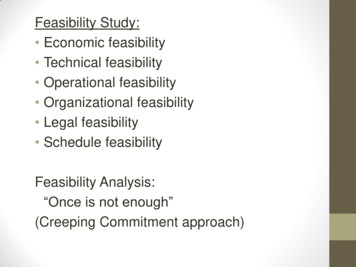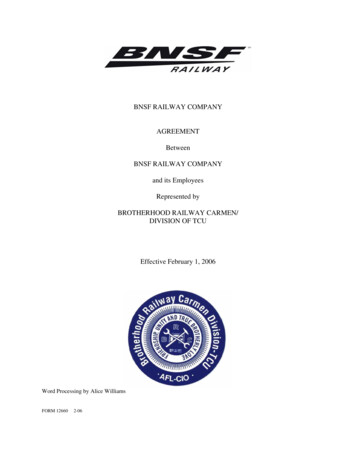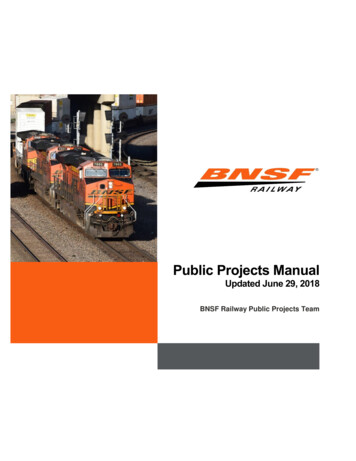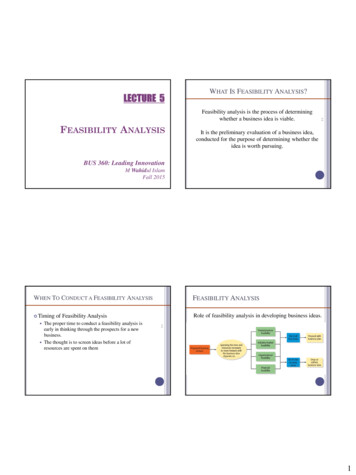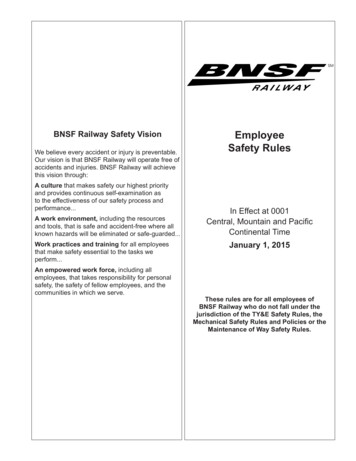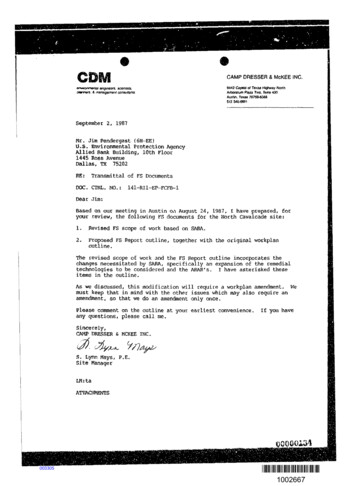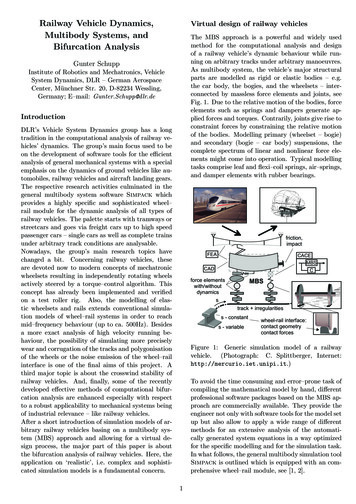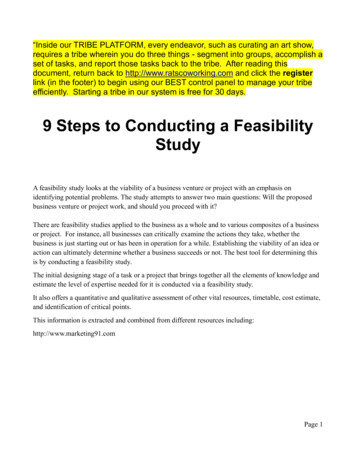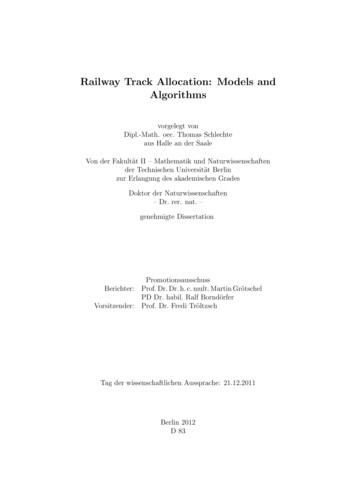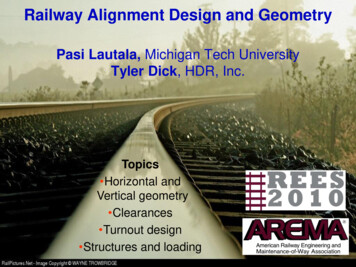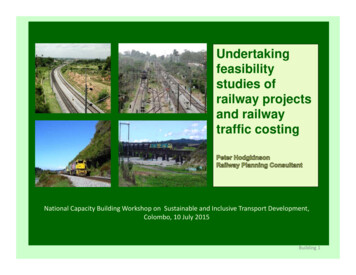
Transcription
Undertakingfeasibilitystudies ofrailway projectsand railwaytraffic costingNational Capacity Building Workshop on Sustainable and Inclusive Transport Development,Colombo, 10 July 2015Building 1
PART 1: Feasibility studies of railway projectsPurpose - Why undertake a feasibility study? Determine whether, and under what conditions, a project will betechnically, financially and economically viable Demonstrate to potential donors that project will produce acceptablecommercial rate of return (i.e. it is both technically and financiallyviable) Demonstrate to governments and to other stakeholders that project willachieve acceptable social, or economic, rate of return2
What is included in a feasibility study of arailway project?- Demand analysis and traffic forecasts- Engineering analysis and technical specs- Capital cost estimation (land acquisition; civil works; signalling,electric power and control system installation; track-laying andinitial rolling stock purchases)- O&M cost estimation (train crew costs; fuel/energy frastructuremaintenance; variable infrastructure maintenance; stationoperating costs)- Financial appraisal (revenue forecast; financing plan; DCFanalysis, including calculation of FIRR and NPV indicators)- Economic appraisal (benefit estimation: reduced operating costs,time savings, reduced emissions, accident cost reduction,reduced road maintenance costs; analysis of economic netbenefit flows (benefits less costs), including calculation of EIRRand B/C indicators)3
Unit development costs of a selection of recent or on‐going railway projects in AsiaProject TypeNew High SpeedPassenger RailNew Urban Mass TransitRailway (Metro)New mixed traffic railway(mainly freight)CountryExample350 km /hour250 km /hourThailandOrange Line, BangkokViet Nam Ho Chi Minh City, Line 1Cambodia Bat Doeng‐Kratie (MG)Cambodia Poipet‐Sisophon (MG)ChinaDali‐Ruili (SG)ChinaYuxi‐Mohan (SG)Lao PDRBoten‐Vientiane (SG)Lao PDRSavannakhet‐Lao Bao (SG)Lao PDRVientiane‐Thanaleng (MG)Sri Lanka Beliatta‐Kataragama (BG)ThailandDenchai‐Chiang Khong (MG)Viet Nam Ho Chi Minh City‐ Loc Ninh (MG)Viet Nam Dong Ha‐Lao Bao (SG)Track doubling and electrification IndiaBengaluru‐Mysore (BG)Phnom Penh‐Sihanoukville (MG)Track rehabilitationCambodiaPortion of PP‐Poipet (MG)ChinaDistance (Km) Terrain/alignmentDevelopment cost(US mill.per km)3519.72584833050741722298832612982138Various (high proportionmountainous)Most undergroundSome undergroundMainly flatFlatHigh proportion mountainousHigh proportion mountainousHigh proportion mountainousHigh proportion mountainousFlatFlat (coastal belt)UndulatingMainly flatSome ly flat0.44VariousSource: Va ri ousMG Metre Gauge (1,000 mm)SG Sta nda rd Ga uge (1,435 mm)BG Broa d Gauge (1,676 mm) Feasibility studies are carried out for wide range of different types of railway projectsList is not exhaustive, but indicates projects which have recently been studied/planned, or arecurrently underway in AsiaDevelopment costs range from nearly 100 million per route-km for construction of new urbanmass transit railways to less than 500,000 per route-km for rehabilitation of existing mixed trafficrailways4
Demand forecasts Vital for accurate forecasting of cash flows in the Financial Analysis andof net economic benefits in the Economic Analysis Many projects have failed to realize the benefits expected of them simplybecause demand has fallen short of forecast levels Since railway assets are long-lived (50 years or more), demandforecasts in terms of freight tonnage/tonne-km and/or passenger volumeshould cover at least 20 operating years beyond the construction period Extensive sensitivity testing of financial and economic results should becarried out for variation of demand from forecast levels If possible, risk analysis should be used to assess the downside risks ofdemand failing to meet forecast levels5
Engineering analysis Basic technical specifications (e.g. maximum or ruling gradient, minimumcurvature, axle loading, loop lengths, station spacings, speeds and signallingrequirements) should be established in advance of the Preliminary Design These will provide basis for Capital Cost estimationCapital cost estimates A works schedule should be established and capital cost estimates (at current unitvalues) prepared within this schedule Capital cost estimates should cover: land acquisition; civil works; track-laying,signalling and power and control system installation; and initial rolling stockacquisition Land acquisition costs will account for major proportion of project developmentcost in urban areas (especially in case of urban mass transit railways) Civil works will account for major share of development cost of projects involvingextensive tunnelling and bridgework (around 50% in case of Chinese High Speedlines) Electric power and control systems, signalling and rolling stock can comprise upto 25% of High Speed development costs (e.g. case of Chinese 350 km/hourlines)6
O&M cost estimates A reliable rail traffic costing model should be used to generate estimates ofOperating and Maintenance costs which will be incurred for 20-30 years after startup Relevant O&M costs include costs of :-train crewsfuel or electric energy consumptionlocomotive and rolling stock maintenanceinfrastructure maintenance (fixed and variable elements)station and train control staff7
Financial appraisal Will comprise a detailed Discounted Cash Flow (DCF) analysis DCF will determine the project’s financial viability under alternative assumptionswith respect to: (a) revenue generation; (b) project capital and O&M costs; and(c) project financing arrangements Positive cash flows will mostly comprise revenue from collection of passengerfares, freight tariffs, or both – in case of High Speed and Urban Transit lines,additional revenue may be collected from retail concessionaires in stations Negative cash flows will comprise its capital, financing and Operating andMaintenance (O&M) costs Project will usually be financed by combination of different sources: Equityfunds, long term foreign government or international agency loans, commercialloans, or in the case of high profile projects (like High Speed lines) from bondissues International development agencies provide loans with lowest interest and mostgenerous pay-back terms, but (like Japanese ODA loans) usually specify anational income qualification Usually the case that FIRR’s of railway projects will fall below specified longterm cost of capital owing to government imposed price controls, high coststructures, or competition from subsidized modes, e.g. road transport8
Economic appraisal Appraisal involves estimation of the net benefits of the project to societythrough a comparison, over its life, of its economic benefits with itseconomic, or shadow-priced, capital and operating costs Shadow pricing involves the removal of taxes and government charges fromcosts, as well as compensation for price distortions (where prices notdetermined by market forces) Different types of railway projects will have different combinations ofeconomic benefits (see following slide) High Speed Passenger Railway will offer substantial time savings comparedwith road and air (when all access costs are considered), whereas freightrailway will not offer time savings but by diverting traffic from road will saveroad operating costs (as its major economic benefit) Railways will have some economic benefits which are not easily measurable,such as reduced exposure of local populations to noxious gas emissions androad traffic noise Except for High Speed Railways in populous countries, such as China, thesavings in Greenhouse Gas emissions due to railways will not be great(small tonnages, valued at low rates) Well designed railway projects will usually achieve significant EIRR’s (in therange of 20-30%) – well in excess of the long term cost of capital9
Economic benefits from different types of railway projectsProject TypeNew High Speed Passenger RailwayNew Urban Mass Transit RailwayNew mixed traffic railway (mainly freight)Track doubling/electrificationTrack rehabilitation/strengtheningRelevant and measurable project benefits (economic appraisal)Value of Reduced Reduced Generated ReducedReducedTimetransport roadtrafficroadGreenhousesavings operating accidentsmaintenance easedcapacity onexisting railnetworkX* Likely to include reduced airport maintenance costs in case of High Speed railways New traffic generation and Value of Time Savings likely to be highest for HighSpeed and Urban Mass Transit railway Development of High Speed and Urban Mass Transit railway will also havegreatest impact in terms of raising land values and of employment generationalong railway routes Freight railways will offer highest reductions in road operating costs, roadaccident costs and road maintenance costs, owing to diversion of traffic awayfrom heavy trucks on national highways10
Some impacts of High Speed Railway development in the Region(World Bank Beijing Office, How China builds high-speed rail for less, 09 October 2014) Dramatic pace of HSR development in China over past decade: 10,000 route-km builtwith further 12,000 route km under construction High density corridors, e.g. Beijing-Shanghai and Beijing-Guangzhou have 350 km/hourHSR’s, while 250 km/hour running design for lower density corridors Chinese 350 km/hour lines have unit development cost of US 17-21 million per km, ascompared with US 25-39 million per km in Europe (and now significantly more in USA) While Chinese capital costs are one third lower than those of Europe, fares charged inChina (US 0.077 per km for 350 km per hour services) are only 20-25% of typical farescharged for comparable European HSR services Likely that European services are self sustaining – therefore Chinese HSR’s with 67% ofthe cost and only 25% of the revenue are likely to be heavily subsidized by Government11
New railway container terminal, Sihanoukville Port (Nippon Koei)Economic appraisal of railway rehabilitation project, Cambodia Revised project involved rehabilitation of about 320 route km of badly degraded track (most onSouthern Line between Phnom Penh and Sihanoukville Port) and construction of new rail containerterminal within Sihanoukville Port Revised project cost US 142.6 million, mostly financed by ADB and AUSAID, completed mid 2015 Initial economic appraisal undertaken in 2006 Economic benefits expected to result from diversion of bulk and container traffic from heavy trucksoperating along three national highways Benefits initially measured for project distributed as follows: Reduced road transport operating cost,89%, reduced CO2 emission cost 3.0%, reduced road accident cost 3.0%, reduced roadmaintenance cost 5% Project estimated to achieve an EIRR of 21%12
PART 2: Traffic costing for vertically integratedrailways Version 2 of the “Traincost” model designed to assist costing ofindividual trains or OD traffic on vertically integrated railways Vertically integrated railways combine provision and maintenanceof infrastructure with operations, unlike vertically separatedrailways and other modes of transport, where these functionsperformed by separate organizations In ESCAP region nearly all railways are vertically integrated (notableexception is Australia) ‐ unlikely to change in foreseeable future Must be understood that traffic costing for a vertically integratedrailway is a complex and difficult process (high level of fixed costs,complex interactions between operations and infrastructuremaintenance, operational constraints affecting costs, etc)13
Costing of point‐to‐point railway traffic– why is it needed? Desire to improve profitability of railways necessarily requires assessment of profit(or financial contribution) at a disaggregated level , i.e. at level of individual ODtraffics or trains, routes and traffic segments Railway accounting systems do not provide disaggregated data for individual routeor traffic analysis Neither are historical costs of railway accounting systems suitable for profitabilityanalysis Profitability of individual routes, trains and traffic segments must be assessed onbasis of operational parameters which determine costs Cost models which are activity or operationally based (such as “Traincost”) providecost estimates for comparison with prevailing prices (freight tariffs or passengerfares) Resulting estimates of financial contribution for individual traffics or trains can beaggregated by route or traffic segment to establish route or traffic profitability Cost estimates can be re‐assessed by varying operating parameters in order toimprove route or traffic profitability14
Common uses of railway traffic costs Cost inputs for assessment of individual traffic, route andtraffic segment profitability, or financial contribution; thus canprovide inputs for Corporate Strategy, Marketing andOperating Plans O&M cost inputs for feasibility or pre‐feasibility studies ofinvestment in railway infrastructure or operating assets (suchas locomotives and rolling stock) Modal cost comparisons (e.g. comparisons of the economiccosts of road and rail and road for given traffic types over arange of distances) Capital cost inputs for capital budgets (infrastructure andoperating asset investment)15
Railway cost structures and segmentation (1) Relatively high proportion of fixed costs (costs which do not vary withtraffic volumes) Fixed % of total O&M costs about 80% for low traffic railways and 40‐50%for high traffic railways Variable costs may be directly calculated for individual traffics and trains Fixed costs have to be allocated to individual trains or traffic – using anappropriate allocation basis “Traincost” allocates fixed costs in direct proportion to the number oftrains operated per year e.g. if container trains comprise 20% of all trainsoperating on a line container traffic will be allocated 20% of fixed costs16
Railway cost structures and segmentation (2)Three cost classifications relevant for assessment of traffic profitability:(i)Short Run Marginal Cost (SRMC) ‐ addition to total costs resulting fromaddition of small increments, such as one more tonne of freight, to totaloutput. Includes only cost elements which vary in the short run (within 12months), such as costs of train crews, energy or fuel consumption,locomotive and rolling stock maintenance, and variable track maintenance(ii)Long Run Marginal Cost (LRMC), or SRMC plus other costs which vary onlyin the longer term (more than 12 months) but are directly attributable totraffic being costed. Examples are capital costs of locomotives,wagons/carriages, and any infrastructure needed to support the costedtraffic(iii) Fully Allocated or Fully Distributed Costs – addition to LRMC of overhead orindirect costs which cannot be associated and do not vary directly withspecific OD traffic. Examples are head office overheads , provision andmaintenance of signalling systems and fixed costs of infrastructuremaintenance. Methods of allocation to specific trains often controversial17
Railway cost structures and segmentation (3)‐ Costs based on model run for intermodal traffic (Double stackcontainer trains)‐ Indirect costs represent about one third of total FD cost18
Model assumes trainloads maximized in line with railway operational constraints19
Freight rolling stockContainer wagonsGeneral freight wagonsBogie van or boxcarDouble ‐stack container wagon (4 TEU)Single tier container wagon (2 TEU)Bulk freight wagonsPneumatic Discharge CementWagon20
Passenger rolling stockPush‐Pull DMU set in Sri LankaEMU set, Gyeongchun Line Rep.of KoreaDiesel locomotive hauled passengertrain in IndiaElectric locomotive hauled passengertrain in India21
Assembly of unit operating cost data for input to model Some railway organizations maintain highly detailed data relating to physical parametersand costs One example is Indian Railways which makes available on its website “IR StatisticalStatements” for various years up to and including most recent From this website it is possible to assemble accounting data (by Zonal Railway) and tocompute all necessary unit operating cost data for input to the Traincost model Recent involvement in a coal haulage project in Pakistan enabled assembly of thefollowing unit costs for PR and private operationUnits rupees, except as where otherwise indicatedS/N1UNIT COST ITEMTrain crew cost per train hour (1)2Fuel consumption, Litres per '000 GTK3Unit cost of diesel fuel, litre4Unit cost of loco maintenance, per loco-km (diesel)5Unit cost of wagon maintenance, per wagon km6Variable cost of track maintenance, per GTK7Fixed cost of route inf. maintenance, per track-km per year8Station staffing cost per route-km per year (8)Overheads as % of fixed and variable costs (9)9Sources:PR operationPrivate 5882,957882,95725%10%1. Ministry of Railways, Government of Pakistan, Year Book 2011-12.2. Financial Review for month of June (Final) 2012, 2013, 2014.Notes:(1)(2)(3)(4)(5)(6)(7)(8)(9)Train crew comprises a Driver, Assistant Driver and Train GuardFuel consumption for a 4,000 HP diesel-electric locomotive, with a hauling capacity of 2,400 tonnes on near level grade.Based on retail price of diesel fuel near Karachi in early December 2014Inclusive of the cost of scheduled overhauls, unscheduled repairs and running maintenance (lubrication, brake-block replacement, sanding, and fuelling)Inclusive of the cost of scheduled overhauls, unscheduled repairs and running maintenance (eg lubrication, brake-block replacement)Track maintenance cost which varies with the level of gross passing tonnage - principal cost components: rail replacement; ballast replacementInclusive of the fixed cost of track maintenance cost (principally daily inspection cost), as well as signalling and communications system maintenanceInclusive of the salary and wages cost of: station staff, train control staff, and level crossing protection staff, all of which are regarded as fixed costsPrimcipal item is administrative overhead cost22
.Thank you for your kind attention!23
4 Unit development costs of a selection of recent or on‐going railway projects in Asia Country Distance (Km) Terrain/alignment New High Speed 350 km /hour 20.77 Passenger Rail 250 km /hour 14.01 New Urban Mass Transit Thailand Orange Line, Bangkok 35 Most underground 94.18 Railway (Metro) Viet Nam Ho Chi Minh City, Line 1 19.7 Some underground 55.40
